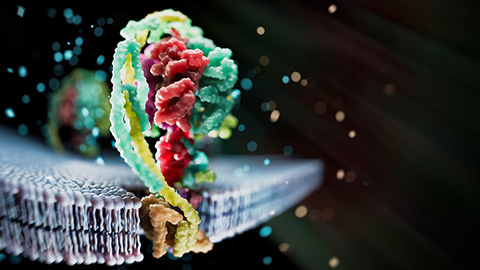Mass spec method captures proteins in native membranes
Cell function depends on how proteins and lipids are organized in native membranes, but studying those interactions has been difficult. Most approaches require extracting membrane proteins, or MPs, and stabilizing them in detergents that disrupt native interactions.

In a recent Molecular & Cellular Proteomics article, Wonhyeuk Jung and colleagues at Yale University and the University of Nebraska–Lincoln developed a protocol using supercharger-assisted prequadrupole activation and mass spectrometry. The approach combines collision-induced and electron-capture dissociation to fragment ions and detect proteins directly in intact membranes.
Applying this method to E. coli membranes, the team detected diverse protein complexes preserved in their natural state and demonstrated that the platform can track drug binding to antibiotic targets. They plan to refine the method by adding biochemical interventions to study any membrane protein directly in its native environment.
Enjoy reading ASBMB Today?
Become a member to receive the print edition four times a year and the digital edition monthly.
Learn moreGet the latest from ASBMB Today
Enter your email address, and we’ll send you a weekly email with recent articles, interviews and more.
Latest in Science
Science highlights or most popular articles

Laser-assisted cryoEM method preserves protein structure
University of Wisconsin–Madison researchers devised a method that prevents protein compaction during cryoEM prep, restoring natural structure for mass spec studies. The approach could expand high-resolution imaging to more complex protein systems.

Method sharpens proteome-wide view of structural changes
Researchers developed a method that improves limited proteolysis coupled with mass spectrometry, separating true changes from abundance or splicing effects.

Discoveries made possible by DNA
The discovery of DNA’s double helix revealed how genetic information is stored, copied and expressed. Revisit that breakthrough and traces how it laid the foundation for modern molecular biology, genomics and biotechnology.

Unraveling the language of histones
Philip Cole presented his research on how posttranslational modifications to histones are involved in gene expression and how these modifications could be therapeutically targeted to treat diseases like cancer.

How Alixorexton could transform narcolepsy treatment
A new investigational drug, alixorexton, targets the brain’s orexin system to restore wakefulness in people with narcolepsy type 1. Alkermes chemist Brian Raymer shares how molecular modeling turned a lab idea into a promising phase 3 therapy.

Phosphatases and pupils: A dual legacy
Yale professor Anton Bennett explores how protein tyrosine phosphatases shape disease, while building a legacy of mentorship that expands opportunity and fuels discovery in biochemistry and molecular biology.

